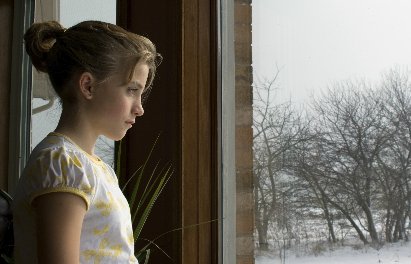 The signs of winter are here: the clocks have been reset and the first snow has fallen. It’s common to feel sad, irritable, and have less energy during the winter months, but some people are more deeply affected—namely those that suffer from Seasonal Affective Disorder (SAD). SAD is a type of depression related to changes in the seasons and is almost always brought about by the darker days of winter.
The signs of winter are here: the clocks have been reset and the first snow has fallen. It’s common to feel sad, irritable, and have less energy during the winter months, but some people are more deeply affected—namely those that suffer from Seasonal Affective Disorder (SAD). SAD is a type of depression related to changes in the seasons and is almost always brought about by the darker days of winter.
Who Gets SAD?
According to the American Academy of Pediatrics, 10 to 20 percent of Americans may feel the effects of this seasonal depression each year. Although the onset of SAD doesn’t usually occur until around age 20, if your child is prone to depression throughout the year, it’s definitely something you should look out for during these shorter days.
Like other forms of depression, females are about four times more likely than males to develop SAD, as are people with relatives who have had depression. Individual biology, brain chemistry, family history, environment, and life experiences also might make some people more prone to SAD and other forms of depression.
Symptoms of SAD Include:
- Changes in mood: sadness, irritability, and/or feelings of hopelessness or worthlessness most of the time for at least 2 weeks; tendency to be more self-critical and more sensitive than usual to criticism; crying or getting upset more often or more easily
- Lack of enjoyment: loss of interest in things that are normally enjoyable; feeling like tasks can’t be accomplished as well as before; feelings of dissatisfaction or guilt
- Low energy: unusual tiredness or unexplained fatigue
- Changes in sleep: sleeping much more than usual (which can make it difficult for kids with SAD to get up and get ready for school in the morning)
- Changes in eating: craving simple carbohydrates (i.e., comfort foods and sugary foods); tendency to overeat (which could result in weight gain during the winter months)
- Difficulty concentrating: more trouble than usual completing assignments on time; lack of usual motivation (which can affect school performance and grades)
- Less time socializing: spending less time with friends in social or extracurricular activities
How Can You Help?
- See a professional. It’s important to get the correct diagnosis for your child. A mental health professional can also offer valuable treatment suggestions.
- Expose your child to natural and/or artificial light. Treatment for SAD often involves increased exposure to light during winter months. For someone with mild symptoms, it may be enough to spend more time outside during the daylight hours, maybe by exercising or taking a daily walk. Full-spectrum (daylight) lightbulbs that fit in regular lamps can help bring a bit more daylight into winter months and might help with mild symptoms. More severe symptoms may be treated with a stronger light that simulates daylight. A special lightbox or panel is placed on a tabletop or desk, and the person sits in front of it briefly every day (45 minutes or so, usually in the morning) with eyes open, glancing — not staring — occasionally at the light (to work, the light has to be absorbed through the retinas). Symptoms tend to improve within a few days or weeks. Generally, light therapy is used until enough sunlight is available outdoors. Like any treatment, phototherapy should be used under a doctor’s supervision.
- Help with homework. You may have to temporarily provide hands-on assistance to help your child organize assignments or complete work. Explain that concentration problems are part of SAD and that things will get better again. Kids and teens with SAD may not realize this and worry that they’re incapable of doing the schoolwork. You may also want to talk to the teachers and ask for extensions on assignments until things get better with treatment.
- Establish a sleep routine. Encourage your child to stick to a regular bedtime every day to reap the mental health benefits of daytime light.
- Help your child to eat right. Encourage your child to avoid loading up on simple carbohydrates and sugary snacks. Provide plenty of whole grains, vegetables, and fruits.
- Be patient. Don’t expect symptoms to go away immediately. Remember that low motivation, low energy, and low mood are part of SAD — it’s unlikely that your child will respond cheerfully to your efforts to help.
- Take care of yourself: Parents can also be affected by SAD or experience low energy during the winter months. Make sure to take care of yourself, too.
Search Our Blog
Our Instagram
Recent Posts
- Bringing Music Into the Hospital to Enhance Care February 2, 2017
- “Though He Be But Little, He is Fierce . . . ” A Parent Reflects on Baby Born with Terminal Disease January 6, 2017
- Patients & Families Travel to the North Pole - Courtesy of Delta Air Lines December 24, 2016
- E-Cigarettes: Could Your Teen Get Hooked on a Harmful Habit December 20, 2016
- Does Your Family Cocoon to Help Fight the Flu? December 5, 2016
Our Most Popular Posts
 5 Acupressure Points Every Parent Should Know 27 views
5 Acupressure Points Every Parent Should Know 27 views - What You Did That Helped Me the Most: A Letter From a Patient to His Mom 15 views
- “Belief & Hope Make it So Much Easier to Endure . . . ” Patient Reflects on Her Long Road to Healing 11 views
 Street Safety: 10 Pedestrian Safety Tips for Kids 8 views
Street Safety: 10 Pedestrian Safety Tips for Kids 8 views - “Though He Be But Little, He is Fierce . . . ” A Parent Reflects on Baby Born with Terminal Disease 7 views
- “Excellent Care, Kind Words, & Loving Support . . . ” Teen Fights to Keep Her Beating Heart 5 views
 “We Have Seen Many Miracles . . . ” the Healing Journey for a Baby With Omphalocele 5 views
“We Have Seen Many Miracles . . . ” the Healing Journey for a Baby With Omphalocele 5 views  Ed Clark, MD, Steps Down as Chief Medical Officer of Primary Children’s Hospital 4 views
Ed Clark, MD, Steps Down as Chief Medical Officer of Primary Children’s Hospital 4 views  Children with Trisomy 13 and 18 attend special Primary Children’s clinic 4 views
Children with Trisomy 13 and 18 attend special Primary Children’s clinic 4 views  First In Nation to Receive GE Revolution Low-Dose CT Scanner 4 views
First In Nation to Receive GE Revolution Low-Dose CT Scanner 4 views
Archives
- February 2017 (1)
- January 2017 (1)
- December 2016 (3)
- November 2016 (1)
- October 2016 (5)
- September 2016 (4)
- August 2016 (6)
- July 2016 (4)
- June 2016 (4)
- May 2016 (1)
- April 2016 (3)
- March 2016 (5)
- February 2016 (6)
- January 2016 (7)
- December 2015 (5)
- November 2015 (8)
- October 2015 (8)
- September 2015 (2)
- August 2015 (1)
- July 2015 (3)
- June 2015 (2)
- May 2015 (2)
- March 2015 (3)
- February 2015 (2)
- January 2015 (2)
- November 2014 (1)
- October 2014 (1)
- September 2014 (3)
- August 2014 (2)
- July 2014 (4)
- June 2014 (2)
- May 2014 (4)
- April 2014 (6)
- March 2014 (4)
- February 2014 (1)
- September 2013 (1)
- February 2013 (1)
- June 2012 (1)















Add comment